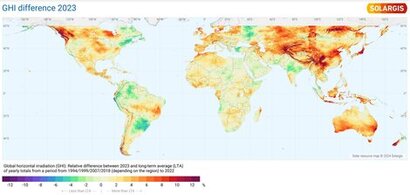
Solar power reached a critical ‘tipping point’ in 2023, becoming the most cost-effective and dominant source of electricity globally by 2050, according to recent reports. Solargis’ latest annual solar irradiance analysis for 2023 demonstrates that this was supported by stable and above-average solar irradiance in many regions. This is despite 2023 experiencing increasingly severe and more frequent climate change challenges, including being the hottest year ever recorded.
Map of GHI Difference 2023 – Australia
Map of GHI Difference 2023 - Southeast Asia
Throughout 2023, Australia and Southeast Asia experienced higher than average solar irradiance, thanks to favourable weather conditions and reduced cloud cover. These regions exceeded their long-term averages by 2 percent and 10 percent, respectively.
Map of GHI Difference 2023 - USA
Map of GHI Difference 2023 – Africa
The US also saw stable solar performance, with some regions benefiting from the El Niño effect that brought more sunshine and less precipitation. Central America enjoyed stronger than average solar irradiance, while Africa maintained its steady and consistent solar resource.
Map of GHI Difference 2023 – Europe
Europe, generally, benefited from higher-than-average solar irradiance, especially in southern Nordic regions. This was due to the reduced cloudiness and rainfall, potentially associated with La Niña in the early part of 2023. Most of Europe exceeded its long-term average by between 1 percent and 7 percent.
“Across 2023, solar power stood as a shining beacon of hope amidst an unprecedented climate crisis and soaring global temperatures” said Marcel Suri, CEO & Founder, Solargis. “Our analysis shows that solar irradiance was remarkably stable or even higher than usual in many regions, supporting the growth and competitiveness of industry against other energy sources.”
However, extreme weather conditions present challenges and risks to solar projects at the regional level. More frequent and severe hailstorms, particularly in the US and Australia, are causing severe losses and affecting the insurability of projects. While it remains difficult to accurately forecast its effects, the El Niño phenomenon, expected to persist until April 2024, may potentially also exacerbate extreme weather events in solar hotspots.
Map of GHI Difference 2023 – India
Amongst these challenges, India continued to suffer from a long-term dip in solar performance, mainly due to the prolonged and intense monsoon season that reduced the solar resource availability. Central India was below its long-term average by between 1 percent and 5 percent, but Southeast India was up to 5 percent above the long-term average, thanks to extremely dry and sunny June and August.
Map of GHI Difference 2023 – South America
La Niña also affected some parts of South America, including Southern Brazil, reducing the solar resource availability.
As the industry adapts to a changing climate, stakeholders must address stable power grids, solar financing in developing economies and supply chain capacity in 2024 and beyond. With climate conditions in flux, solar investors and operators must also closely monitor resource variability patterns and navigate potential barriers and opportunities using the best possible solar resource data and software available.
“Changing global weather patterns may alter the outlook for 2024” Mr Suri added. “There is an increased need for stakeholders to closely monitor and analyse solar resource trends. This is crucial for optimising projects and mitigating the ongoing risks in the face of changing climate dynamics. As we navigate through the extremes, stakeholders must enhance their monitoring, analysing, and optimising capabilities to mitigate risks and embrace the unstoppable ascent of solar power in our global energy landscape.”
For additional information:

